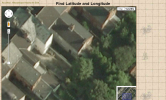 Find latitude and longitude
Find latitude and longitudeThis website will give you the latitude and longitude of your observatory to the inch. Very handy for use with astronomy computer programs that require your location, like StarryNight, TheSky, CNebulaX, etc.
On this page is a series of links to other webpages around the Tinter-web, which I have found useful if not indispensable in my career as an amateur astronomer.
 Find latitude and longitude
Find latitude and longitude
This website will give you the latitude and longitude of your observatory to the inch. Very handy for use with astronomy computer programs that require your location, like StarryNight, TheSky, CNebulaX, etc.
* * *
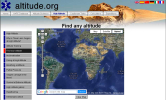 Find altitude
Find altitude
Having discovered your latitude and longitude co-ordinates, you may wish to use this website to discover your altitude above sea level, also for use with astronomy computer programs that require such information.
* * *
 NOAA Magnetic Field Calculators
NOAA Magnetic Field Calculators
Again, using your latitude and longitude co-ordinates, this website (managed by the United States' National Oceanographic and Atmospheric Association) will give you the magnetic declination for your location, that is to say the offset of magnetic north from true north. I find this useful for polar aligning my equatorial telescope mount with a magnetic compass, since my house is in the way of Polaris and celestial north.
* * *
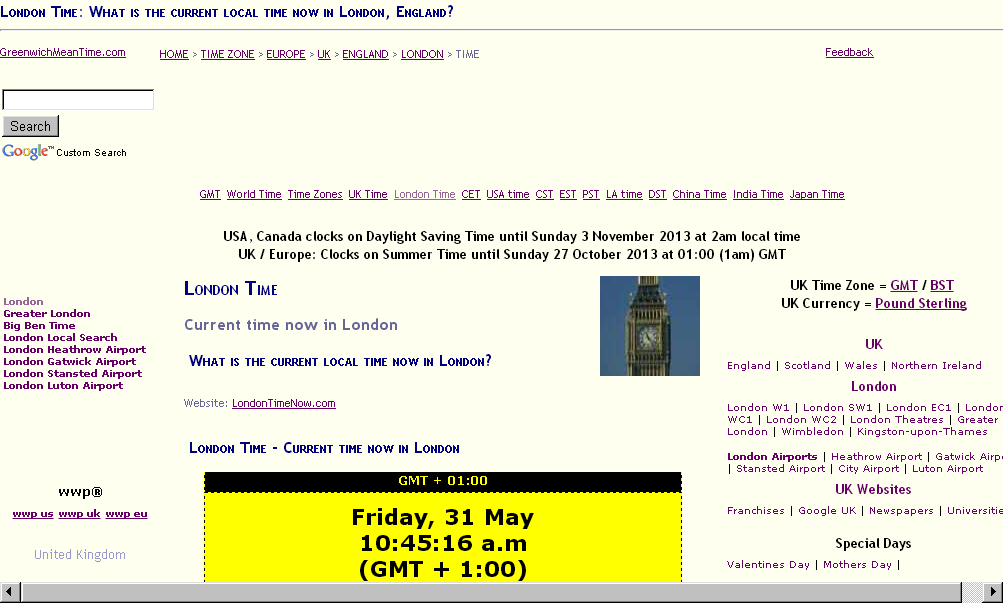 London Time
London Time
This website is very handy for synchronizing timepieces with Universal Time, which for convenience's sake is identical to Greenwich Mean Time.
* * *
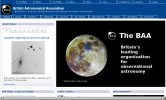 British Astronomical Association
British Astronomical Association
The BAA keeps a lot of useful information at the different Sections. There are a lot of useful .pdf circulars, and resources like comet ephemerides, planetary maps, Mars graticules, Lunar prediction DOS programs; in fact the Lunar Section is especially good. And if you send in your observations, they get analysed by experts and sometimes published.
* * *
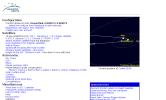 Heavens Above
Heavens Above
This versatile website, maintained by Chris Peat, is very useful for predicting satellite and other spacecraft passes, and planning comet observations, amongst other things. A good party trick is to look up the time of a bright satellite flare from your location, wait for the right time, point to the sky and say: 'Watch this...' and see the reaction when a flare appears in the sky at the end of your finger. It is also handy for identifying UFOs, of which astronomers see many nowadays.
* * *
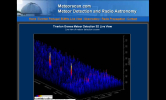 Tiverton Graves Meteor Detection 3D Live View
Tiverton Graves Meteor Detection 3D Live View
This website uses radio beams to detect ionisation trails in the atmosphere caused by meteors. I look at this website (with one eye covered to maintain some night vision capability) if I'm staying up to watch a meteor shower and nothing appears to be happening.
* * *
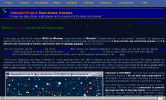 CNebulaX by José Ramón Torres Lapasió
CNebulaX by José Ramón Torres Lapasió
CNebulaX (pronounced: 'See-NEB-yu-lacks'; well that's how I pronounce it anyway) is a wonderful piece of free software which will make any star chart that most amateur astronomers could ever need. It uses the Hubble Space Telescope Guide Star Catalogue v. 1.2 which includes 25,000,000 stars down to magnitude 15. The author modestly claims that this is just his hobby and not his real work. Whatever. If his 'real work' was so important he'd be sharing that with the world instead. The important thing is that this essential piece of software has been provided as a service to the astronomical community and anyone may use it free of charge.
* * *
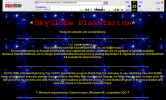 SkyGlobe by KlassM Software
SkyGlobe by KlassM Software
This webpage contains links to DOS and Windows versions of SkyGlobe Planetarium, a computer planetarium program by the now defunct KlassM Software Inc. dating from the late 1980s/early 1990s. Whilst it hasn't nearly the scope of CNebulaX, I find it most useful for quickly calculating the right ascension and declination of Sol and bright daytime planets, for daylight planetary observations.
* * *
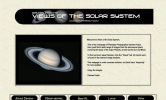 Damien Peach's Views of the Solar System
Damien Peach's Views of the Solar System
Damien Peach is a famous amateur astronomer based in Selsey, UK, and one of those handful of amateur astronomers in the world whose Earth-based planetary images appear to be actually better than the Hubble Space Telescope images taken from orbit. How do they do it? Anyway, I have found this site very useful and reliable for checking my own more subjective drawings against.
* * *
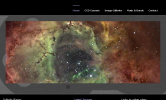 CCD Land
CCD Land
This is a website of detailed deep sky CCD images taken by astrophotographer and astronomy lecturer Nik Szymanek. I was fortunate enough to be able to attend one of his talks, and he modestly insists that anyone can take photographs as fine as his. Apparently you don't have to be wealthy as such, but you do need some specialist equipment, and you do need to set up your telescope right next to one of the world's great observatories!
* * *
 SOHO Data Archive
SOHO Data Archive
This website has a database of full Solar images for every day going back for, I don't know at least ten years. Very handy for checking past observations against.
* * *
 Solar Observing by Peter Meadows
Solar Observing by Peter Meadows
This is perhaps the best site on the Internet for Solar observation. Come here after you've been completely nonplussed by the BAA Solar Section website. Mr. Meadows knows his stuff. His Helio Viewer program in the Software section is indispensable for calculating heliographic latitude and longitude and position angles, etc.
* * *
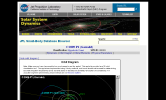 JPL Small-Body Database Browser
JPL Small-Body Database Browser
This website, maintained by NASA's Jet Propulsion Laboratory, shows orbital data for any asteroid or comet on the JPL database.
* * *
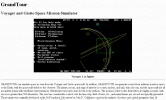 GrandTour Voyager and Giotto Space Mission Simulator
GrandTour Voyager and Giotto Space Mission Simulator
GrandTour is a DOS computer program developed between 1982 and 1987 by John D. Callahan at the Jet Propulsion Laboratory, to assist in the analysis of data returned from the Voyager and Giotto space probes. Basically it's a wireframe simulation of the views from these spacecraft, or indeed from anywhere in their vicinity, at any time during their missions. It is of great historical interest, particularly since no space probes have visited Uranus or Neptune before or since Voyager, and Giotto was the first space probe to fly-by a comet. This page contains a download link for the program package.
* * *
 The Cardboard Diffraction Micrometer by John Pazmino
The Cardboard Diffraction Micrometer by John Pazmino
This is a great article by John Pazmino of NYSkies Astronomy Inc. It describes how you can make a device out of cereal packets that can make meaningful measurements of the separations of binary star systems, and monitor their changing separations over time (over decades in fact).
* * *
 Double Stars to Follow by Martin Gaskell
Double Stars to Follow by Martin Gaskell
This webpage is part of the Prairie Astronomy Club website. It features a fascinating article by Martin Gaskell listing different binary star systems whose changing separations may be readily monitored.
* * *
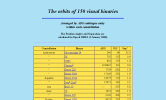 Orbits of Visual Binaries
Orbits of Visual Binaries
This website, © 1996-2010 Richard Dibon-Smith is meant FOR PERSONAL USE ONLY. Basically it seems to be the only place on the 'net which has orbital diagrams for double stars. But then the diagrams only show the apparent motion of one star about the other, not the actual motion of both stars around their common centre of gravity. And then some of the orbital periods of these stars are of the order of over a century so there is no basis of reliable observation from which the orbital diagrams could have been calculated. They're still as good a starting point as currently exists anywhere for exploring the layout of other star systems. Oh and did I mention, all files at the website are © 1996-2010 Richard Dibon-Smith and meant FOR PERSONAL USE ONLY? Have a look at this page at the website:
'Plagiarists I have known'. The bit where he complains to the webmaster, in all seriousness, about some primary schoolchildren supposedly infringing his copyright by publishing a webpage on the constellarions is hysterical. Just don't tell him I sent you; I haven't actually asked this god if he would condescend to be gracious enough to allow me his kind permission to post a link to his website.
* * *
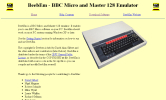 BeebEm
BeebEm
At this website may be found a link to BeebEm, a BBC Microcomputer emulator. The BBC Micro is an educational home computer produced by Acorn Computers in 1981 and built around a MOS Technologies 6502 processor with 2MHz clock speed. The computer includes 32Kb of user RAM and 32Kb of operating system ROM. It is the ROM that makes the computer useful; it comprises a very powerful BASIC language interpreter and a 6502 assembler, which makes the machine very easy to control. One of these machines is rumoured to still be controlling the great radio telescope at Jodrell Bank. Its graphics modes are capable of a highest resolution of 640×256 pixels in 1-bit colour (black or white), 320×256 in 2-bit (four colours), or 160×256 in 4-bit (sixteen colours, actually eight colours with eight further flashing colours). This is adequate for drawing most diagrams where mathematical precision is important. I use the BBC primarily for drawing accurate templates of planetary discs at different phases of illumination.
* * *
 ElectrEm
ElectrEm
At this website may be found a link to ElectrEm, an Acorn Electron emulator. The Acorn Electron is a budget version of the BBC Microcomputer released in 1983, with 2MHz 6502A microprocessor, 32Kb RAM and 32Kb ROM running a slightly improved version of BBC BASIC. In most respects it behaves identically to the BBC Micro, and for most purposes the choice of emulator between BeebEm and ElectrEm is purely a matter of personal preference. But historically the Beeb version of ELITE was far superior to the Elk version.
* * *
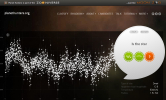 Planet Hunters
Planet Hunters
This website, part of the so-called 'Zooniverse', enables you to sift through stellar light-curves obtained by the Kepler space telescope, whose mission is to search for planets in other star systems along the Cygnus-Orion Galactic Spur (the unconnected spiral arm of the Milky Way Galaxy which Sol is situated in the middle of) so orientated with respect to Terra that they can be detected transiting the tiny discs of their remote parent stars. The number of such planets discovered in such a fortuitous alignment agrees with the statistical expectation that most if not all stars in the Galaxy possess planetary systems. I know this because I was fortunate enough to be able to attend a talk given by Dr. Bill Chaplin about the Kepler mission. Dr. Chaplin supervises an international team working on precisely this aspect of the mission's research from his position at the University of Birmingham, Warwickshire. Some planets have even been discovered by amateurs sifting through the data at this website. So good luck!
* * *
 UK Astronomy Buy & Sell
UK Astronomy Buy & Sell
A classified advertisements section for astronomical equipment. You can find some rare bits and pieces here. I picked up my 6" f/5 achromat OTA for less than £200 here. With a motorized focuser, 32mm wide field eyepiece and a couple of Baader filters. Including delivery. Well I think I got a bargain anyway. Now I'm just looking for a Fullerscopes Mk. IV equatorial mount. Wish me luck.
* * *
 M. M. J. Meijer's SPC900NC webpage.
M. M. J. Meijer's SPC900NC webpage.
This webpage features a very useful account of how to dismantle a Philips SPC900NC webcam for the purpose of adapting it for astrophotography. The Philips SPC900NC is the last major webcam produced that uses a CCD sensor which can be adapted for astrophotography, and is the first choice for amateur planetary photography, in conjunction with image processing software like Registax (see next link). If you want to use one of these things, you'll also need an adaptor to fit the webcam into your telescope eyepiece, and an infrared cut filter, since the CCD is sensitive to infrared. The webcam simply replaces your telescope eyepiece.
* * *
 Registax 6
Registax 6
This page contains download links for the Registax free software, created by Cor Berrevoets. This program takes your video footage of an astronomical objective, captured with a CCD camera, and stacks all the clearest frames together to make a best image. It is the only software of its type, and everyone uses it. Although I still use Registax 5; the new version doesn't agree with me.
* * *
 BBC The Sky at Night Archive
BBC The Sky at Night Archive
This website features amongst other things links to old broadcasts of the BBC's astronomy magazine The Sky at Night, hosted for nearly 56 years by Patrick Moore.
* * *
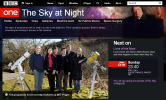 BBC The Sky at Night
BBC The Sky at Night
This is a link to the current BBC The Sky at Night website, which features guides to the night sky for northern hemisphere observers.
* * *
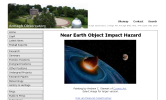 Armagh Observatory
Armagh Observatory
Now not a lot of people know this, but Armagh Observatory is currently the front line of Planetary Defence against Catastrophic Impact from Outer Space. The British Government has been trying to close them down for years now, unsuccessfully. Here you will find advice about what to do when the worst comes to pass and Universal Apodosis visits this planet yet again.
 William Diffin's Astronomy Webpages
William Diffin's Astronomy Webpages
And this is the only link back to the index page of my website, unless you press the <BACK> button on your browser. Or you could go somewhere else.